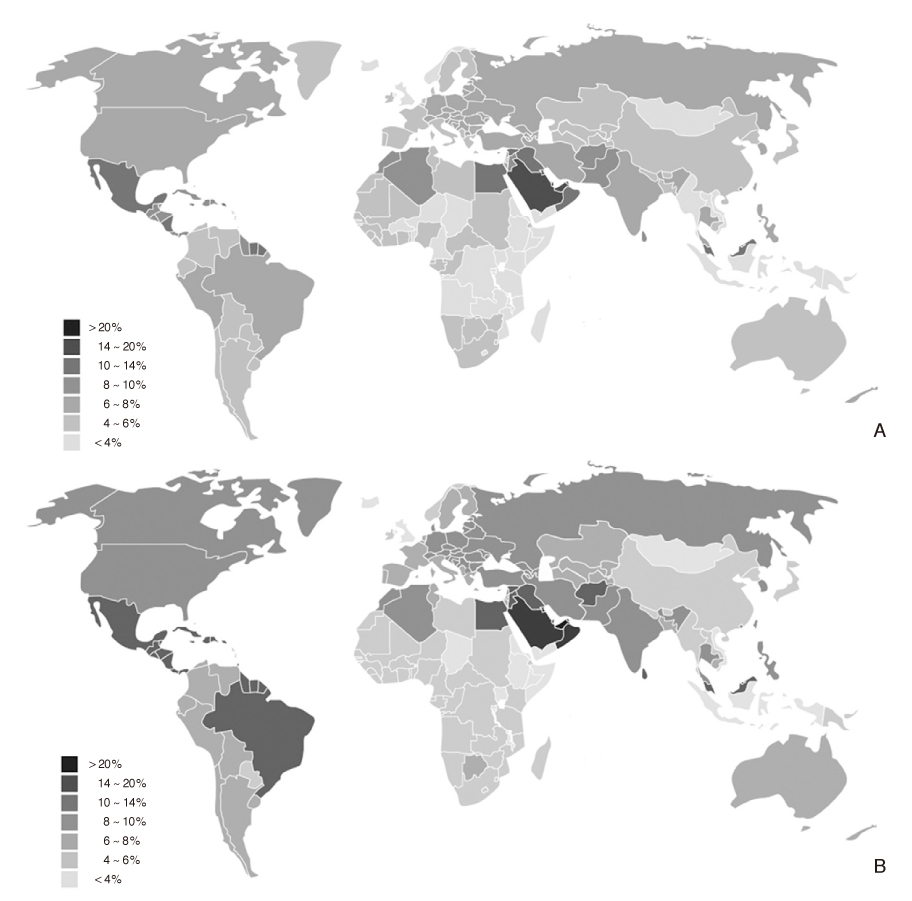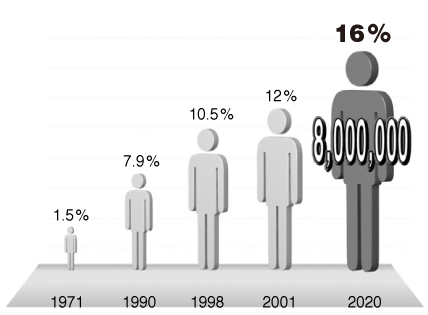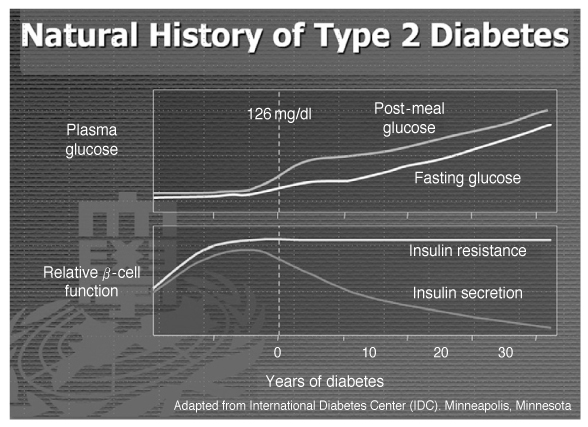 |
 |
- Search
| J Korean Med Assoc > Volume 51(9); 2008 > Article |
Abstract
Despite the advancements in medical sciences, some diseases are becoming epidemic worldwide. One such disease is type 2 diabetes mellitus (T2DM), a chronic disorder linked in part to lifestyle. T2DM is associated with an increased frequency of cardiovascular as well as cerebrovascular diseases, causing significant morbidity and mortality among affected patients. According to recent reports, in Asian countries including Korea, the increasing trends are more significant and the estimated average increases are predicted to surpass the worldwide average. In addition, epidemiological investigations have shown that the onset of disease in Asians is earlier. The complications associated with disease, therefore, occur earlier and the predicted lifespan of affected individuals is known to be shorter. Therefore, improved understanding of the pathophysiology of T2DM is needed for improved prevention, early diagnosis, and disease intervention. However, most of the basic knowledge on the etiology and epidemiology of diabetes is based on reports from Western countries. Thus, they do not reflect the different characteristics of Asian ethnicity, lifestyles, and economics. Several metabolic problems are associated with the development of type 2 diabetes mellitus in a complex manner. In particular, with the deterioration of insulin resistance, the aggravation of the insulin secretory function is understood to play a key role in explaining the pathogenesis of T2DM in our population. In particular, the deterioration of insulin secretion may be an indispensable condition that is inevitable for the development of T2DM in individuals. Even if the insulin resistance of individuals were aggravated limitlessly, a normal glucose tolerance of individuals could be maintained if adequate corresponding compensatory insulin secretion occurs. Further characterization of diabetes in our population is necessary through prospective clinical study.
References
1. Pickup JC, Williams G. Textbook of diabetes 2003;3rd ed. Malden, Mass: Blackwell Science.
2. Yoon KH, Lee JH, Kim JW, Cho JH, Choi YH, Ko SH, Zimmet P, Son HY. Epidemic obesity and type 2 diabetes in Asia. Lancet 2006;368:1681-1688.
3. International Diabetes Federation. Diabetes Atlas 2006;3rd ed.
4. Roglic G, King H. Diabetes mellitus in Asia. Hong Kong Med J 2000;6:10-11.
5. Ko GT, Chan JC, Cockram CS, Woo J. Prediction of hypertension, diabetes, dyslipidaemia or albuminuria using simple anthropometric indexes in Hong Kong Chinese. Int J Obes Relat Metab Disord 1999;23:1136-1142.
6. He J, Klag MJ, Whelton PK, Chen JY, Qian MC, He GQ. Body mass and blood pressure in a lean population in southwestern China. Am J Epidemiol 1994;139:380-389.
7. Park Y, Lee H, Koh CS, Min H, Yoo K, Kim Y, Shin Y. Prevalence of diabetes and IGT in Yonchon County, South Korea. Diabetes Care 1995;18:545-548.
8. Kim YI, Choi CS, Kim SW, Lee JS, Kim HH, Lee KU. Prevalence of diabetes and impaired glucose tolerance in Jeongup population. J Korean Diabetes Assoc 1988;22:361-371.
9. Department of Health and Social Wellfare. National Nutritional Survey 2005 2007.
10. Office of statistics. Mortality data of year 2004 2005.
11. DeFronzo RA. Pathogenesis of type 2 diabetes mellitus. Med Clin North Am 2004;88:787-835. ix.
12. Nesher R, Della Casa L, Litvin Y, Sinai J, Del Rio G, Pevsner B, Wax Y, Cerasi E. Insulin deficiency and insulin resistance in type 2 (non-insulin-dependent) diabetes: quantitative contributions of pancreatic and peripheral responses to glucose homeostasis. Eur J Clin Invest 1987;17:266-274.
13. Beck-Nielsen H, Hother-Nielsen O, Vaag A, Alford F. Pathogenesis of type 2 (non-insulin-dependent) diabetes mellitus: the role of skeletal muscle glucose uptake and hepatic glucose production in the development of hyperglycaemia. A critical comment. Diabetologia 1994;37:217-221.
14. Muniyappa R, Montagnani M, Koh KK, Quon MJ. Cardiovascular actions of insulin. Endocr Rev 2007;28:463-491.
15. Semenkovich CF. Insulin resistance and atherosclerosis. J Clin Invest 2006;116:1813-1822.
16. Kahn SE. Clinical review 135: The importance of beta-cell failure in the development and progression of type 2 diabetes. J Clin Endocrinol Metab 2001;86:4047-4058.
17. Leahy JL. Natural history of beta-cell dysfunction in NIDDM. Diabetes Care 1990;13:992-1010.
18. Weyer C, Bogardus C, Mott DM, Pratley RE. The natural history of insulin secretory dysfunction and insulin resistance in the pathogenesis of type 2 diabetes mellitus. J Clin Invest 1999;104:787-794.
19. Lillioja S, Mott DM, Spraul M, Ferraro R, Foley JE, Ravussin E, Knowler WC, Bennett PH, Bogardus C. Insulin resistance and insulin secretory dysfunction as precursors of non-insulin-dependent diabetes mellitus. Prospective studies of Pima Indians. N Engl J Med 1993;329:1988-1992.
20. Martin BC, Warram JH, Krolewski AS, Bergman RN, Soeldner JS, Kahn CR. Role of glucose and insulin resistance in development of type 2 diabetes mellitus: results of a 25-year follow-up study. Lancet 1992;340:925-929.
21. Rhee SY, Kwon MK, Park BJ, Chon S, Jeong IK, Oh S, Ahn KJ, Chung HY, Kim SW, Kim JW, Kim YS, Woo JT. Differences in Insulin Sensitivity and Secretory Capacity Based on OGTT in Subjects with Impaired Glucose Regulation. Korean J Intern Med 2007;22:270-274.
22. Rhee SY, Chon S, Oh S, Kim SW, Kim JW, Kim YS, Woo JT. Insulin secretion and insulin resistance in newly diagnosed, drug naive prediabetes and type 2 diabetes patients with/ without metabolic syndrome. Diabetes Res Clin Pract 2007;76:397-403.
23. Yoon KH, Ko SH, Cho JH, Lee JM, Ahn YB, Song KH, Yoo SJ, Kang MI, Cha BY, Lee KW, Son HY, Kang SK, Kim HS, Lee IK, Bonner-Weir S. Selective beta-cell loss and alpha-cell expansion in patients with type 2 diabetes mellitus in Korea. J Clin Endocrinol Metab 2003;88:2300-2308.
24. Rhee SY, Chon S, Oh S, Woo JT, Kim SW, Kim JW, Kim YS. Effects of diabetes on the sense of well-being and life-quality in patients with type 2 diabetes. Diabetic Medicine 2006;P23(S4):735.
25. Monnier L. Is postprandial glucose a neglected cardiovascular risk factor in type 2 diabetes? Eur J Clin Invest 2000;30(S2):3-11.
26. U.K. Prospective Diabetes Study Group. U.K. prospective diabetes study 16. Overview of 6 years' therapy of type II diabetes: a progressive disease. Diabetes 1995;44:1249-1258.
27. UK Prospective Diabetes Study (UKPDS) Group. Intensive blood-glucose control with sulphonylureas or insulin compared with conventional treatment and risk of complications in patients with type 2 diabetes (UKPDS 33). Lancet 1998;352:837-853.
28. Chon S, Koh G, Oh S, Woo JT, Kim SW, Kim JW, Kim YS. The Effect of Intensive Insulin Therapy On Pancreaticβ-Cell Function In Newly Diagnosed Type 2 Diabetic Patients. Diabetes 2005;54(S1):A123.
- TOOLS
-
METRICS

-
Related articles in
J Korean Med Assoc -
Current status of scabies in Korea2023 December;66(12)
Prevalence and treatment status of diabetes mellitus in Korea2023 July;66(7)
Epidemiological characteristics of diabetes mellitus in Korea2022 October;65(10)
Classification and Characteristics of Mechanical Ventilator1997 April;40(4)
Bacteriological Characterisics of Helicobacter pylori Infection1997 September;40(9)









